Adventure Travel · Africa · Chad · Djibouti · Lesotho · Regions · Sao Tome and Principe · Speciality Travel · Sudan
5 unlikely African adventures
From the great pyramids of Giza in the north to the vibrant city of Cape Town, nestled below majestic Table Mountain, in the south, Africa is a continent awash with bucket list destinations. The great Serengeti wildebeest migration, majestic dunes of the Namib, thundering waters of Victoria Falls, the list goes on and on. However, there are also very unlikely corners of the continent that hide some incredible adventures without the crowds. You may even need to add a couple of lines onto your bucket list!
Lesotho – explore the “Roof of Africa” from the saddle
One of only three Kingdoms remaining in Africa, the mountain Kingdom of Lesotho is completely surrounded by South Africa. The moniker given so often, The Roof of Africa, is quite apt. Lesotho is the only independent country in the world that lies entirely above 1,000. In fact, the lowest point in the whole country is some 1,400m above sea level, making it the highest lowest point of any country in the world.
 There is no better way to explore this scenery than from the saddle. Horse riding and pony trekking have long been a favoured mode of transport in these parts. While new roads have been built and 4×4 vehicles can take you around in a fraction of the time, why would you miss out on the chance to explore at a more languid pace. Filling your lungs with the crisp air as you go. Spectacular scenery is literally around every turn and beyond every crest. You can even go skiing in winter, but that is a whole different adventure!
There is no better way to explore this scenery than from the saddle. Horse riding and pony trekking have long been a favoured mode of transport in these parts. While new roads have been built and 4×4 vehicles can take you around in a fraction of the time, why would you miss out on the chance to explore at a more languid pace. Filling your lungs with the crisp air as you go. Spectacular scenery is literally around every turn and beyond every crest. You can even go skiing in winter, but that is a whole different adventure!
 At these altitudes temperatures drop and agriculture takes on more of a subsistence nature. Small thatched stone huts dot the landscape and thin wisps of smoke rising into the cool mountain air from warming fires. Rugged Basotho villagers congregate, wrapped in colourful blankets and crowned with mokorotlos, conical shaped straw hats. The mokorotlo is so integral to life in Lesotho it even takes centre stage on the nation’s flag. Don’t be surprised if you get invited in for tea, and take the chance if you are, it’s one of the pleasures of taking things slowly.
At these altitudes temperatures drop and agriculture takes on more of a subsistence nature. Small thatched stone huts dot the landscape and thin wisps of smoke rising into the cool mountain air from warming fires. Rugged Basotho villagers congregate, wrapped in colourful blankets and crowned with mokorotlos, conical shaped straw hats. The mokorotlo is so integral to life in Lesotho it even takes centre stage on the nation’s flag. Don’t be surprised if you get invited in for tea, and take the chance if you are, it’s one of the pleasures of taking things slowly.
 What’s more the pleasure is not restricted to experienced riders. Day treks on docile mountain ponies to multi-day cross-country trails are just waiting for you.
Djibouti – into the Devil’s Cauldron
From the chilly air on the roof of Africa let’s descend into the baking heat of the lowest point in Africa. Djibouti may be diminutive, but it certainly is dramatic. Cradled in the horn of Africa, this is a land of fire, heat, salt where the very surface of the earth is being ripped apart!
Summer temperatures in parts of Djibouti creep above 50C (120F) and remain balmy even during the depths of winter. Add to this a touch of robust geological activity and you have an otherworldly landscape at every turn.
What’s more the pleasure is not restricted to experienced riders. Day treks on docile mountain ponies to multi-day cross-country trails are just waiting for you.
Djibouti – into the Devil’s Cauldron
From the chilly air on the roof of Africa let’s descend into the baking heat of the lowest point in Africa. Djibouti may be diminutive, but it certainly is dramatic. Cradled in the horn of Africa, this is a land of fire, heat, salt where the very surface of the earth is being ripped apart!
Summer temperatures in parts of Djibouti creep above 50C (120F) and remain balmy even during the depths of winter. Add to this a touch of robust geological activity and you have an otherworldly landscape at every turn.
 In the far west Lake Abbe’s dramatic limestone chimneys rise from the flat plains, belching sulphurous gases while flamingos grace the shallow waters. To the east Lake Assal, at 155m below sea level, is the lowest point in Africa. A vast saline lake flanked with shimmering salt flats making up the world’s largest salt reserve. For millennia the Afar people have traded the precious salt far and wide via camel trains, glimpses of which can still be seen today.
In the far west Lake Abbe’s dramatic limestone chimneys rise from the flat plains, belching sulphurous gases while flamingos grace the shallow waters. To the east Lake Assal, at 155m below sea level, is the lowest point in Africa. A vast saline lake flanked with shimmering salt flats making up the world’s largest salt reserve. For millennia the Afar people have traded the precious salt far and wide via camel trains, glimpses of which can still be seen today.
 To the south east lies the Ardoukoba volcano, formed just 42 years ago, and separating the saline waters of Assal from the Ghoubet Al-Kharab, the Devil’s Cauldron or Gulf of Demons! Surrounded by towering cliffs and mountains, the secrets of the cove lie below the water’s surface. A whole new world opens up. The area is renowned for common sightings of juvenile whale sharks and a host of other fish. Here you’ll also find the famous “Djibouti Crack”, a coral encrusted fissure that separates the great African and Arabian tectonic plates. Divers can actually swim through the chasm separating the land masses.
To the south east lies the Ardoukoba volcano, formed just 42 years ago, and separating the saline waters of Assal from the Ghoubet Al-Kharab, the Devil’s Cauldron or Gulf of Demons! Surrounded by towering cliffs and mountains, the secrets of the cove lie below the water’s surface. A whole new world opens up. The area is renowned for common sightings of juvenile whale sharks and a host of other fish. Here you’ll also find the famous “Djibouti Crack”, a coral encrusted fissure that separates the great African and Arabian tectonic plates. Divers can actually swim through the chasm separating the land masses.
 Follow the tides out of the Ghoubet Al-Kharab and into the Gulf of Tadjoura. From here the waters of the gulf flow onwards, past the Moucha Islands into the Gulf of Aden to the east and northwards to the Red Sea where the northern shores of Djibouti are typified by endless beaches, warm seas and spectacular diving and snorkelling.
Sudan – lost in the sands
If you followed the coast northwards from Djibouti along the Red Sea for long enough you reach Sudan. Although the allure of the Red Sea coast in Sudan is great, it is another waterway that takes centre stage in this adventure, the great Nile River.
Bustling Khartoum is the starting point for most and the point at which the Blue and the White Nile Rivers meet before heading ever further north in search of the Mediterranean. The life-giving waters of the Nile allowed for settlements to flourish in the Sahara Desert, and there is so much to see.
Follow the tides out of the Ghoubet Al-Kharab and into the Gulf of Tadjoura. From here the waters of the gulf flow onwards, past the Moucha Islands into the Gulf of Aden to the east and northwards to the Red Sea where the northern shores of Djibouti are typified by endless beaches, warm seas and spectacular diving and snorkelling.
Sudan – lost in the sands
If you followed the coast northwards from Djibouti along the Red Sea for long enough you reach Sudan. Although the allure of the Red Sea coast in Sudan is great, it is another waterway that takes centre stage in this adventure, the great Nile River.
Bustling Khartoum is the starting point for most and the point at which the Blue and the White Nile Rivers meet before heading ever further north in search of the Mediterranean. The life-giving waters of the Nile allowed for settlements to flourish in the Sahara Desert, and there is so much to see.
 Maybe start by exploring the vast Western Desert for a true taste of the Sahara. Here the driving is often across open desert with nothing but sand in every direction. The horizons occasionally broken by nomadic Bisharin settlements, a sure sign there is likely water nearby. Discover prehistoric rock engravings, ancient fortresses and a quintessential palm studded oasis.
Maybe start by exploring the vast Western Desert for a true taste of the Sahara. Here the driving is often across open desert with nothing but sand in every direction. The horizons occasionally broken by nomadic Bisharin settlements, a sure sign there is likely water nearby. Discover prehistoric rock engravings, ancient fortresses and a quintessential palm studded oasis.
 Inevitably any journey will lead back to the Nile, and a trip through Sudan’s fascinating history, this is after all Nubia, the Kingdom of the Black Pharaohs. As you follow the Nile the area is littered with ancient monuments testifying to the regions glorious past. Two highlights stand out above all else though.
In the shadow of the great Jebel Barkal mountain rising out of the desert sands is the ancient city of Napata. It was from here that the great Pharaoh Taharqa ruled the whole of Upper and Lower Egypt during the twenty-fifth, or Nubian dynasty. At the time this was the centre of the entire Egyptian world.
Inevitably any journey will lead back to the Nile, and a trip through Sudan’s fascinating history, this is after all Nubia, the Kingdom of the Black Pharaohs. As you follow the Nile the area is littered with ancient monuments testifying to the regions glorious past. Two highlights stand out above all else though.
In the shadow of the great Jebel Barkal mountain rising out of the desert sands is the ancient city of Napata. It was from here that the great Pharaoh Taharqa ruled the whole of Upper and Lower Egypt during the twenty-fifth, or Nubian dynasty. At the time this was the centre of the entire Egyptian world.
 When the Nubian Dynasty was forced into retreat, the capital moved south to Meroë, now arguably the most spectacular archaeological site in all of Sudan. Over 40 pyramids rise from the desert forming part of this ancient royal city waiting to be explored. Did you know with over 200 pyramids Sudan actually has more pyramids than Egypt?
Chad – home of an almost mythical safari
We would forgive you for thinking we are taking the Mickey talking about safaris in Chad. However, amongst ardent safari goers, the Zakouma National Park in Chad has definitely become a bucket list destination. This is not a luxury safari as you have come to expect in other parts of Africa, think of it more like the place Indiana Jones would go on safari.
When the Nubian Dynasty was forced into retreat, the capital moved south to Meroë, now arguably the most spectacular archaeological site in all of Sudan. Over 40 pyramids rise from the desert forming part of this ancient royal city waiting to be explored. Did you know with over 200 pyramids Sudan actually has more pyramids than Egypt?
Chad – home of an almost mythical safari
We would forgive you for thinking we are taking the Mickey talking about safaris in Chad. However, amongst ardent safari goers, the Zakouma National Park in Chad has definitely become a bucket list destination. This is not a luxury safari as you have come to expect in other parts of Africa, think of it more like the place Indiana Jones would go on safari.
 The little-known country of Chad sits in the heart of northern-central Africa. The north of the country lies in the middle of the Sahara Desert while the extreme south joins with the tropical rain forests of central Africa. In the transition zone between the two lies the Zakouma National Parks, administered and managed by the exceptional African Parks. African Parks took over the running of the park at the request of the Chadian government in 2010 and the results have been nothing short of spectacular.
When they took over poaching was rampant, almost every species of animal was in decline and the very ecology of the park under threat. Since then African Parks have worked tirelessly with the local communities and security forces to make Zakouma one of the most secure parks in Africa. The bush is being rehabilitated and the wildlife numbers flourishing.
The little-known country of Chad sits in the heart of northern-central Africa. The north of the country lies in the middle of the Sahara Desert while the extreme south joins with the tropical rain forests of central Africa. In the transition zone between the two lies the Zakouma National Parks, administered and managed by the exceptional African Parks. African Parks took over the running of the park at the request of the Chadian government in 2010 and the results have been nothing short of spectacular.
When they took over poaching was rampant, almost every species of animal was in decline and the very ecology of the park under threat. Since then African Parks have worked tirelessly with the local communities and security forces to make Zakouma one of the most secure parks in Africa. The bush is being rehabilitated and the wildlife numbers flourishing.
 Zakouma is one of the few places left in Africa where at times you can see huge herds of elephants. Buffalo herds of over 1,000 congregate, where once less than 250 remained in the whole park. 50% of the world’s Kordofan giraffe are found in Zakouma. Antelope abound. With the thriving numbers of herbivores there has been a corresponding rise in predators, including lion, leopard, cheetah, hyena and wild dog.
With the arrival of the rains in May the park closes to visitors for the wet season, only opening again in November. At the beginning of the dry season the bush is green, there is abundant water and the temperatures are cool in the hours of darkness and early morning. This is a great time for photography but not prime game viewing.
Zakouma is one of the few places left in Africa where at times you can see huge herds of elephants. Buffalo herds of over 1,000 congregate, where once less than 250 remained in the whole park. 50% of the world’s Kordofan giraffe are found in Zakouma. Antelope abound. With the thriving numbers of herbivores there has been a corresponding rise in predators, including lion, leopard, cheetah, hyena and wild dog.
With the arrival of the rains in May the park closes to visitors for the wet season, only opening again in November. At the beginning of the dry season the bush is green, there is abundant water and the temperatures are cool in the hours of darkness and early morning. This is a great time for photography but not prime game viewing.
 As the months progress the water dries up, and the temperatures begin to climb. By March and April the dry season is at its peak and day time temperatures frequently hover in the mid-40s centigrade (around 110 Fahrenheit), but this is when the magic happens. Masses of game flock around the remaining water and the experience can hold its own against any national park in Africa.
As the months progress the water dries up, and the temperatures begin to climb. By March and April the dry season is at its peak and day time temperatures frequently hover in the mid-40s centigrade (around 110 Fahrenheit), but this is when the magic happens. Masses of game flock around the remaining water and the experience can hold its own against any national park in Africa.
 If the mammals are impressive, the birdlife is out of this world, frankly legendary. The park sits slap bang in the middle of migratory routes and is an essential Sahelian refuge and RAMSAR site. Flocks of more than a million red-billed queleas blacken the sky and black crowned cranes fill the pans in flocks larger than recorded anywhere else on earth. That is before we even start on the bee-eaters, hornbills, spoonbills, barbets and did we mention the largest population of red-necked ostriches in the world?
São Tomé and Príncipe – Atlantic Idyll
After all this activity, wouldn’t it be great if there was just somewhere to kick back, relax on a white sand beach, away from the crowds and soak up the African sun. Strange you should ask! We have just solution, the tiny island nation of São Tomé and Príncipe cosseted away in the Gulf of Guinea.
If the mammals are impressive, the birdlife is out of this world, frankly legendary. The park sits slap bang in the middle of migratory routes and is an essential Sahelian refuge and RAMSAR site. Flocks of more than a million red-billed queleas blacken the sky and black crowned cranes fill the pans in flocks larger than recorded anywhere else on earth. That is before we even start on the bee-eaters, hornbills, spoonbills, barbets and did we mention the largest population of red-necked ostriches in the world?
São Tomé and Príncipe – Atlantic Idyll
After all this activity, wouldn’t it be great if there was just somewhere to kick back, relax on a white sand beach, away from the crowds and soak up the African sun. Strange you should ask! We have just solution, the tiny island nation of São Tomé and Príncipe cosseted away in the Gulf of Guinea.
 Two verdant tropical dots rise majestically from the deep blue ocean. São Tomé the larger of the two is the point of entry to the country, and São Tomé City is the hub of life on the islands. Please note that the terms “City” and “hub” are used loosely by Western senses. Life here happens more at the speed of the tortoise than the hare, and after a few days you will see that it is so much more rewarding that way. A riot of colour assaults the senses from the bright yellows of the taxis to the faded pastels of once grand Portuguese colonial structures. Brightly coloured houses give way to pavements strewn with a rainbow of fruit and vegetables as hawkers sell their bounty.
Two verdant tropical dots rise majestically from the deep blue ocean. São Tomé the larger of the two is the point of entry to the country, and São Tomé City is the hub of life on the islands. Please note that the terms “City” and “hub” are used loosely by Western senses. Life here happens more at the speed of the tortoise than the hare, and after a few days you will see that it is so much more rewarding that way. A riot of colour assaults the senses from the bright yellows of the taxis to the faded pastels of once grand Portuguese colonial structures. Brightly coloured houses give way to pavements strewn with a rainbow of fruit and vegetables as hawkers sell their bounty.
 Inland the forest is king, dense and rich and teaming with life, shrouding the mountainous terrain. The Pico Cão, unwilling to be subjugated to the jungle surrounds rises straight up nearly 400m above the forest, dominating the views from far and wide. On the fertile lower slopes plantations produce abundant crops from the fertile soil, including the island’s celebrated cocoa trees. In the early 1900’s this tiny nation was the world’s largest producer of cocoa earning them the nickname the “Chocolate Islands”. Even today São Tomé cocoa is considered some of the finest in the world.
Inland the forest is king, dense and rich and teaming with life, shrouding the mountainous terrain. The Pico Cão, unwilling to be subjugated to the jungle surrounds rises straight up nearly 400m above the forest, dominating the views from far and wide. On the fertile lower slopes plantations produce abundant crops from the fertile soil, including the island’s celebrated cocoa trees. In the early 1900’s this tiny nation was the world’s largest producer of cocoa earning them the nickname the “Chocolate Islands”. Even today São Tomé cocoa is considered some of the finest in the world.
 A short flight north east takes you to the smaller of the two islands, Príncipe. If São Tomé is laid back, Princípe is positively comatose. You may want to take an excursion deep into the forests, or maybe explore one of the cocoa plantations or even head off in search of nesting turtles, but you could just relax on one of the islands achingly beautiful beaches instead. After all, you have come here to get away from it all, and here you are just about as far away from modern life as you can get, so just revel in it.
Warwick Blow is Owner of Safari In Style. Safari In Style uses more than 50 years of personal experience to create tailor-made unique journeys through Africa’s finest safari destinations.
If you would like to be a guest blogger on A Luxury Travel Blog in order to raise your profile, please contact us.
A short flight north east takes you to the smaller of the two islands, Príncipe. If São Tomé is laid back, Princípe is positively comatose. You may want to take an excursion deep into the forests, or maybe explore one of the cocoa plantations or even head off in search of nesting turtles, but you could just relax on one of the islands achingly beautiful beaches instead. After all, you have come here to get away from it all, and here you are just about as far away from modern life as you can get, so just revel in it.
Warwick Blow is Owner of Safari In Style. Safari In Style uses more than 50 years of personal experience to create tailor-made unique journeys through Africa’s finest safari destinations.
If you would like to be a guest blogger on A Luxury Travel Blog in order to raise your profile, please contact us.
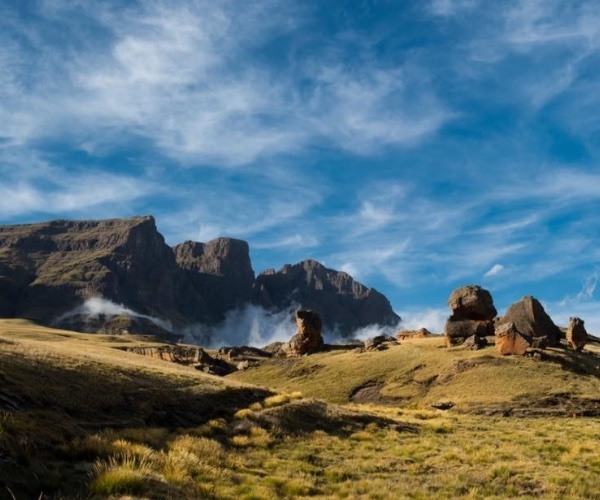 There is no better way to explore this scenery than from the saddle. Horse riding and pony trekking have long been a favoured mode of transport in these parts. While new roads have been built and 4×4 vehicles can take you around in a fraction of the time, why would you miss out on the chance to explore at a more languid pace. Filling your lungs with the crisp air as you go. Spectacular scenery is literally around every turn and beyond every crest. You can even go skiing in winter, but that is a whole different adventure!
There is no better way to explore this scenery than from the saddle. Horse riding and pony trekking have long been a favoured mode of transport in these parts. While new roads have been built and 4×4 vehicles can take you around in a fraction of the time, why would you miss out on the chance to explore at a more languid pace. Filling your lungs with the crisp air as you go. Spectacular scenery is literally around every turn and beyond every crest. You can even go skiing in winter, but that is a whole different adventure!
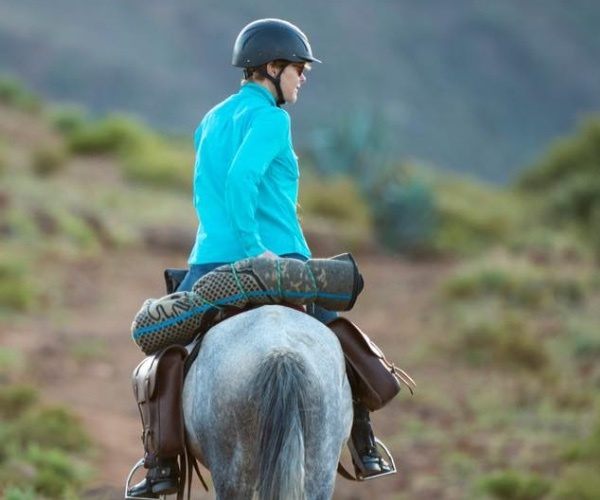 At these altitudes temperatures drop and agriculture takes on more of a subsistence nature. Small thatched stone huts dot the landscape and thin wisps of smoke rising into the cool mountain air from warming fires. Rugged Basotho villagers congregate, wrapped in colourful blankets and crowned with mokorotlos, conical shaped straw hats. The mokorotlo is so integral to life in Lesotho it even takes centre stage on the nation’s flag. Don’t be surprised if you get invited in for tea, and take the chance if you are, it’s one of the pleasures of taking things slowly.
At these altitudes temperatures drop and agriculture takes on more of a subsistence nature. Small thatched stone huts dot the landscape and thin wisps of smoke rising into the cool mountain air from warming fires. Rugged Basotho villagers congregate, wrapped in colourful blankets and crowned with mokorotlos, conical shaped straw hats. The mokorotlo is so integral to life in Lesotho it even takes centre stage on the nation’s flag. Don’t be surprised if you get invited in for tea, and take the chance if you are, it’s one of the pleasures of taking things slowly.
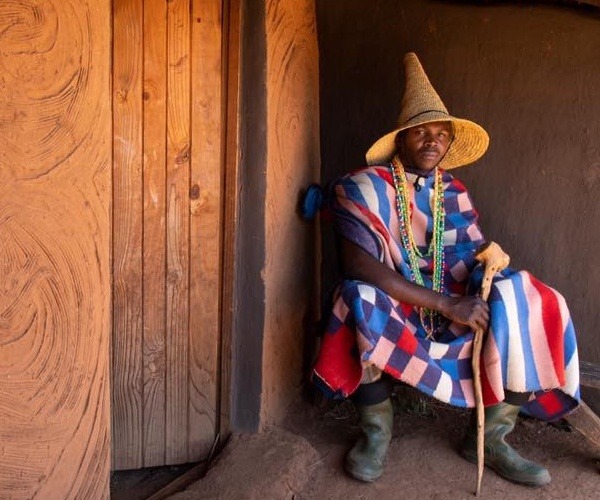 What’s more the pleasure is not restricted to experienced riders. Day treks on docile mountain ponies to multi-day cross-country trails are just waiting for you.
Djibouti – into the Devil’s Cauldron
From the chilly air on the roof of Africa let’s descend into the baking heat of the lowest point in Africa. Djibouti may be diminutive, but it certainly is dramatic. Cradled in the horn of Africa, this is a land of fire, heat, salt where the very surface of the earth is being ripped apart!
Summer temperatures in parts of Djibouti creep above 50C (120F) and remain balmy even during the depths of winter. Add to this a touch of robust geological activity and you have an otherworldly landscape at every turn.
What’s more the pleasure is not restricted to experienced riders. Day treks on docile mountain ponies to multi-day cross-country trails are just waiting for you.
Djibouti – into the Devil’s Cauldron
From the chilly air on the roof of Africa let’s descend into the baking heat of the lowest point in Africa. Djibouti may be diminutive, but it certainly is dramatic. Cradled in the horn of Africa, this is a land of fire, heat, salt where the very surface of the earth is being ripped apart!
Summer temperatures in parts of Djibouti creep above 50C (120F) and remain balmy even during the depths of winter. Add to this a touch of robust geological activity and you have an otherworldly landscape at every turn.
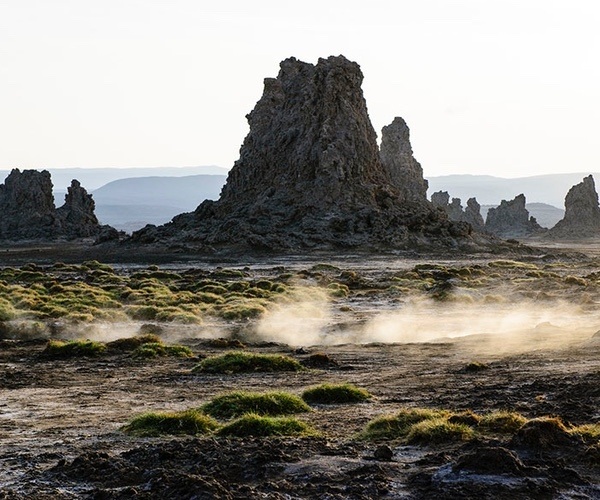 In the far west Lake Abbe’s dramatic limestone chimneys rise from the flat plains, belching sulphurous gases while flamingos grace the shallow waters. To the east Lake Assal, at 155m below sea level, is the lowest point in Africa. A vast saline lake flanked with shimmering salt flats making up the world’s largest salt reserve. For millennia the Afar people have traded the precious salt far and wide via camel trains, glimpses of which can still be seen today.
In the far west Lake Abbe’s dramatic limestone chimneys rise from the flat plains, belching sulphurous gases while flamingos grace the shallow waters. To the east Lake Assal, at 155m below sea level, is the lowest point in Africa. A vast saline lake flanked with shimmering salt flats making up the world’s largest salt reserve. For millennia the Afar people have traded the precious salt far and wide via camel trains, glimpses of which can still be seen today.
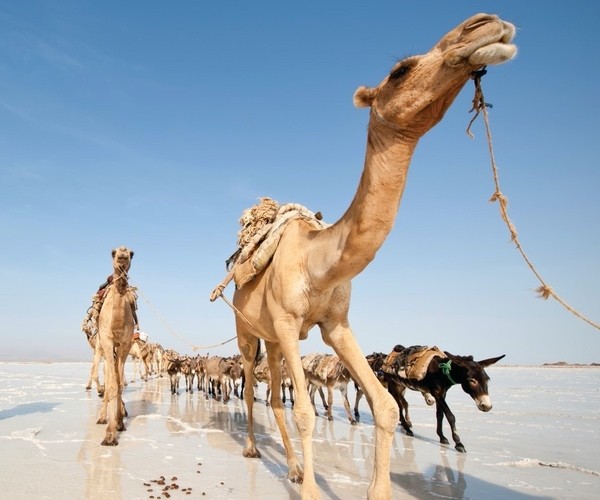 To the south east lies the Ardoukoba volcano, formed just 42 years ago, and separating the saline waters of Assal from the Ghoubet Al-Kharab, the Devil’s Cauldron or Gulf of Demons! Surrounded by towering cliffs and mountains, the secrets of the cove lie below the water’s surface. A whole new world opens up. The area is renowned for common sightings of juvenile whale sharks and a host of other fish. Here you’ll also find the famous “Djibouti Crack”, a coral encrusted fissure that separates the great African and Arabian tectonic plates. Divers can actually swim through the chasm separating the land masses.
To the south east lies the Ardoukoba volcano, formed just 42 years ago, and separating the saline waters of Assal from the Ghoubet Al-Kharab, the Devil’s Cauldron or Gulf of Demons! Surrounded by towering cliffs and mountains, the secrets of the cove lie below the water’s surface. A whole new world opens up. The area is renowned for common sightings of juvenile whale sharks and a host of other fish. Here you’ll also find the famous “Djibouti Crack”, a coral encrusted fissure that separates the great African and Arabian tectonic plates. Divers can actually swim through the chasm separating the land masses.
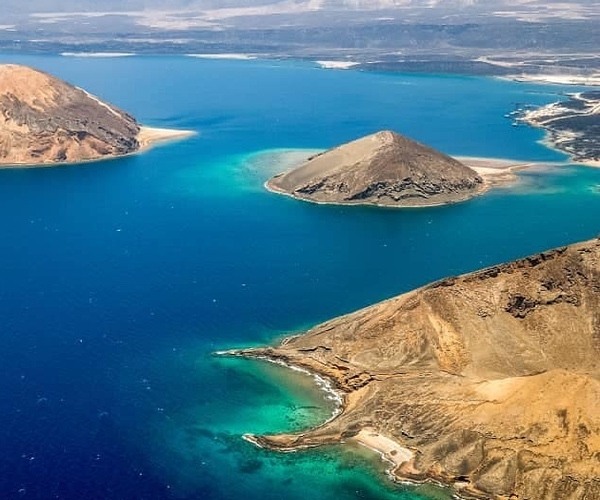 Follow the tides out of the Ghoubet Al-Kharab and into the Gulf of Tadjoura. From here the waters of the gulf flow onwards, past the Moucha Islands into the Gulf of Aden to the east and northwards to the Red Sea where the northern shores of Djibouti are typified by endless beaches, warm seas and spectacular diving and snorkelling.
Sudan – lost in the sands
If you followed the coast northwards from Djibouti along the Red Sea for long enough you reach Sudan. Although the allure of the Red Sea coast in Sudan is great, it is another waterway that takes centre stage in this adventure, the great Nile River.
Bustling Khartoum is the starting point for most and the point at which the Blue and the White Nile Rivers meet before heading ever further north in search of the Mediterranean. The life-giving waters of the Nile allowed for settlements to flourish in the Sahara Desert, and there is so much to see.
Follow the tides out of the Ghoubet Al-Kharab and into the Gulf of Tadjoura. From here the waters of the gulf flow onwards, past the Moucha Islands into the Gulf of Aden to the east and northwards to the Red Sea where the northern shores of Djibouti are typified by endless beaches, warm seas and spectacular diving and snorkelling.
Sudan – lost in the sands
If you followed the coast northwards from Djibouti along the Red Sea for long enough you reach Sudan. Although the allure of the Red Sea coast in Sudan is great, it is another waterway that takes centre stage in this adventure, the great Nile River.
Bustling Khartoum is the starting point for most and the point at which the Blue and the White Nile Rivers meet before heading ever further north in search of the Mediterranean. The life-giving waters of the Nile allowed for settlements to flourish in the Sahara Desert, and there is so much to see.
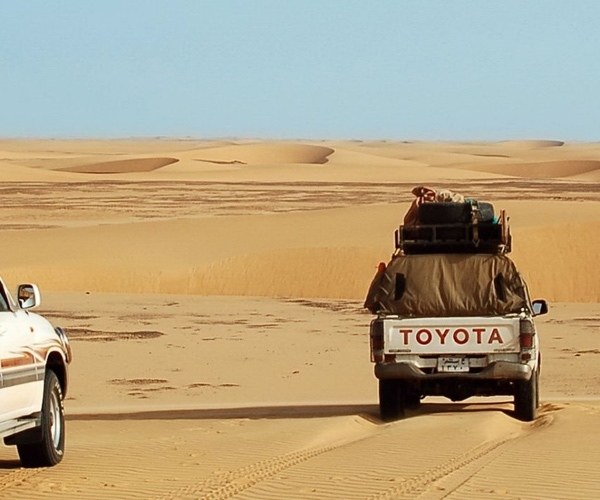 Maybe start by exploring the vast Western Desert for a true taste of the Sahara. Here the driving is often across open desert with nothing but sand in every direction. The horizons occasionally broken by nomadic Bisharin settlements, a sure sign there is likely water nearby. Discover prehistoric rock engravings, ancient fortresses and a quintessential palm studded oasis.
Maybe start by exploring the vast Western Desert for a true taste of the Sahara. Here the driving is often across open desert with nothing but sand in every direction. The horizons occasionally broken by nomadic Bisharin settlements, a sure sign there is likely water nearby. Discover prehistoric rock engravings, ancient fortresses and a quintessential palm studded oasis.
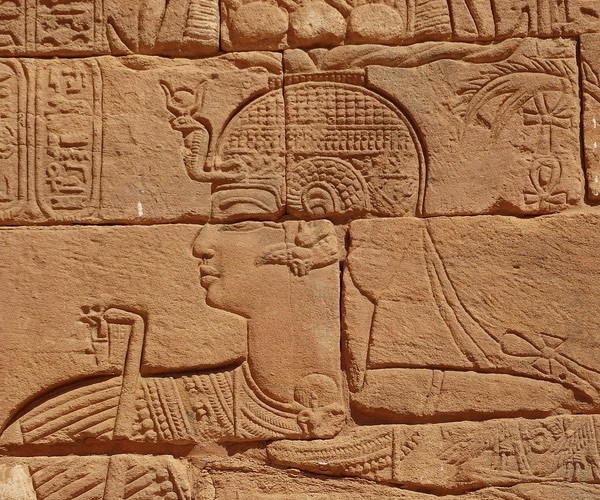 Inevitably any journey will lead back to the Nile, and a trip through Sudan’s fascinating history, this is after all Nubia, the Kingdom of the Black Pharaohs. As you follow the Nile the area is littered with ancient monuments testifying to the regions glorious past. Two highlights stand out above all else though.
In the shadow of the great Jebel Barkal mountain rising out of the desert sands is the ancient city of Napata. It was from here that the great Pharaoh Taharqa ruled the whole of Upper and Lower Egypt during the twenty-fifth, or Nubian dynasty. At the time this was the centre of the entire Egyptian world.
Inevitably any journey will lead back to the Nile, and a trip through Sudan’s fascinating history, this is after all Nubia, the Kingdom of the Black Pharaohs. As you follow the Nile the area is littered with ancient monuments testifying to the regions glorious past. Two highlights stand out above all else though.
In the shadow of the great Jebel Barkal mountain rising out of the desert sands is the ancient city of Napata. It was from here that the great Pharaoh Taharqa ruled the whole of Upper and Lower Egypt during the twenty-fifth, or Nubian dynasty. At the time this was the centre of the entire Egyptian world.
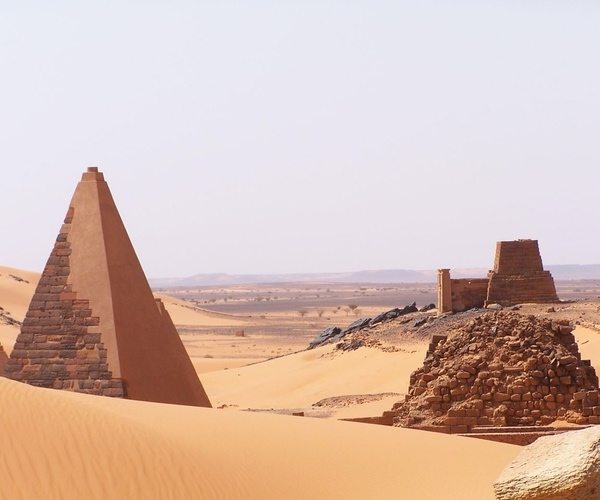 When the Nubian Dynasty was forced into retreat, the capital moved south to Meroë, now arguably the most spectacular archaeological site in all of Sudan. Over 40 pyramids rise from the desert forming part of this ancient royal city waiting to be explored. Did you know with over 200 pyramids Sudan actually has more pyramids than Egypt?
Chad – home of an almost mythical safari
We would forgive you for thinking we are taking the Mickey talking about safaris in Chad. However, amongst ardent safari goers, the Zakouma National Park in Chad has definitely become a bucket list destination. This is not a luxury safari as you have come to expect in other parts of Africa, think of it more like the place Indiana Jones would go on safari.
When the Nubian Dynasty was forced into retreat, the capital moved south to Meroë, now arguably the most spectacular archaeological site in all of Sudan. Over 40 pyramids rise from the desert forming part of this ancient royal city waiting to be explored. Did you know with over 200 pyramids Sudan actually has more pyramids than Egypt?
Chad – home of an almost mythical safari
We would forgive you for thinking we are taking the Mickey talking about safaris in Chad. However, amongst ardent safari goers, the Zakouma National Park in Chad has definitely become a bucket list destination. This is not a luxury safari as you have come to expect in other parts of Africa, think of it more like the place Indiana Jones would go on safari.
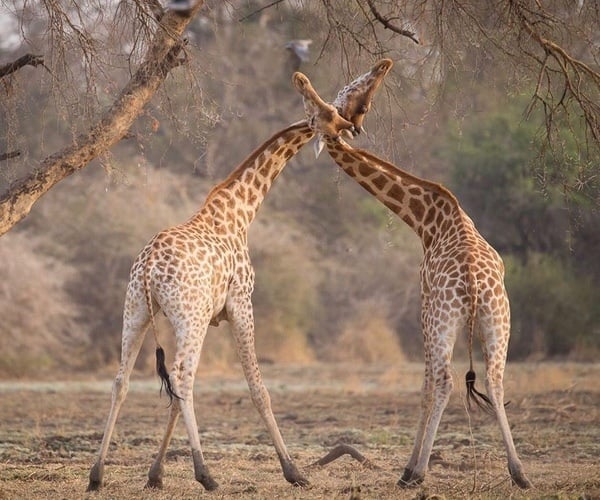 The little-known country of Chad sits in the heart of northern-central Africa. The north of the country lies in the middle of the Sahara Desert while the extreme south joins with the tropical rain forests of central Africa. In the transition zone between the two lies the Zakouma National Parks, administered and managed by the exceptional African Parks. African Parks took over the running of the park at the request of the Chadian government in 2010 and the results have been nothing short of spectacular.
When they took over poaching was rampant, almost every species of animal was in decline and the very ecology of the park under threat. Since then African Parks have worked tirelessly with the local communities and security forces to make Zakouma one of the most secure parks in Africa. The bush is being rehabilitated and the wildlife numbers flourishing.
The little-known country of Chad sits in the heart of northern-central Africa. The north of the country lies in the middle of the Sahara Desert while the extreme south joins with the tropical rain forests of central Africa. In the transition zone between the two lies the Zakouma National Parks, administered and managed by the exceptional African Parks. African Parks took over the running of the park at the request of the Chadian government in 2010 and the results have been nothing short of spectacular.
When they took over poaching was rampant, almost every species of animal was in decline and the very ecology of the park under threat. Since then African Parks have worked tirelessly with the local communities and security forces to make Zakouma one of the most secure parks in Africa. The bush is being rehabilitated and the wildlife numbers flourishing.
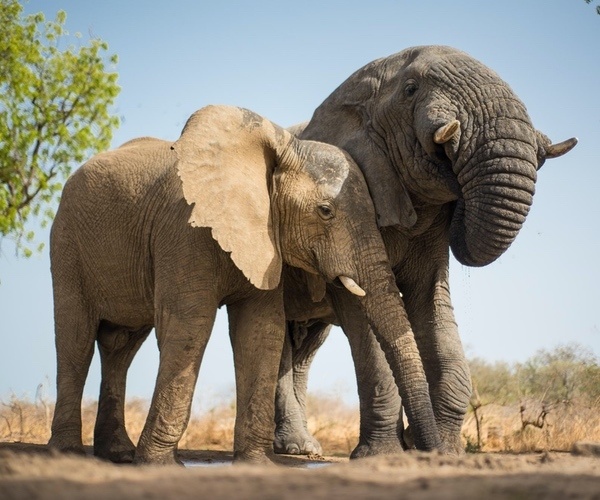 Zakouma is one of the few places left in Africa where at times you can see huge herds of elephants. Buffalo herds of over 1,000 congregate, where once less than 250 remained in the whole park. 50% of the world’s Kordofan giraffe are found in Zakouma. Antelope abound. With the thriving numbers of herbivores there has been a corresponding rise in predators, including lion, leopard, cheetah, hyena and wild dog.
With the arrival of the rains in May the park closes to visitors for the wet season, only opening again in November. At the beginning of the dry season the bush is green, there is abundant water and the temperatures are cool in the hours of darkness and early morning. This is a great time for photography but not prime game viewing.
Zakouma is one of the few places left in Africa where at times you can see huge herds of elephants. Buffalo herds of over 1,000 congregate, where once less than 250 remained in the whole park. 50% of the world’s Kordofan giraffe are found in Zakouma. Antelope abound. With the thriving numbers of herbivores there has been a corresponding rise in predators, including lion, leopard, cheetah, hyena and wild dog.
With the arrival of the rains in May the park closes to visitors for the wet season, only opening again in November. At the beginning of the dry season the bush is green, there is abundant water and the temperatures are cool in the hours of darkness and early morning. This is a great time for photography but not prime game viewing.
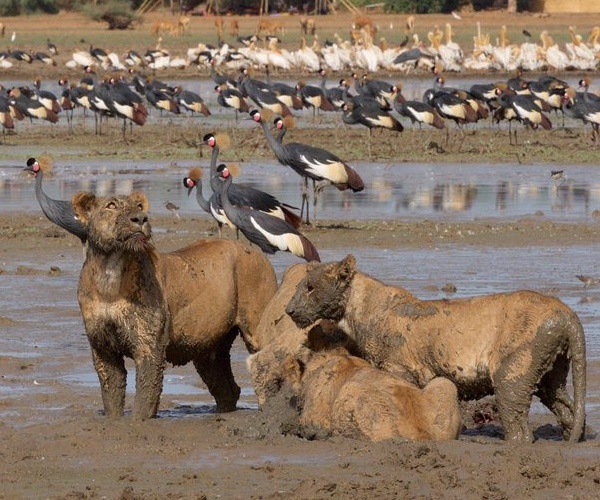 As the months progress the water dries up, and the temperatures begin to climb. By March and April the dry season is at its peak and day time temperatures frequently hover in the mid-40s centigrade (around 110 Fahrenheit), but this is when the magic happens. Masses of game flock around the remaining water and the experience can hold its own against any national park in Africa.
As the months progress the water dries up, and the temperatures begin to climb. By March and April the dry season is at its peak and day time temperatures frequently hover in the mid-40s centigrade (around 110 Fahrenheit), but this is when the magic happens. Masses of game flock around the remaining water and the experience can hold its own against any national park in Africa.
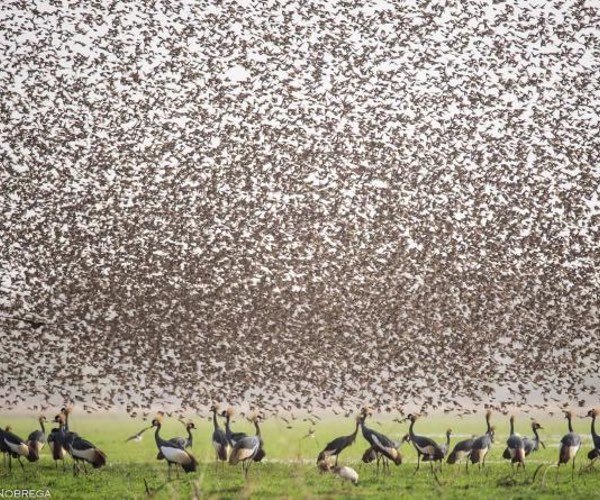 If the mammals are impressive, the birdlife is out of this world, frankly legendary. The park sits slap bang in the middle of migratory routes and is an essential Sahelian refuge and RAMSAR site. Flocks of more than a million red-billed queleas blacken the sky and black crowned cranes fill the pans in flocks larger than recorded anywhere else on earth. That is before we even start on the bee-eaters, hornbills, spoonbills, barbets and did we mention the largest population of red-necked ostriches in the world?
São Tomé and Príncipe – Atlantic Idyll
After all this activity, wouldn’t it be great if there was just somewhere to kick back, relax on a white sand beach, away from the crowds and soak up the African sun. Strange you should ask! We have just solution, the tiny island nation of São Tomé and Príncipe cosseted away in the Gulf of Guinea.
If the mammals are impressive, the birdlife is out of this world, frankly legendary. The park sits slap bang in the middle of migratory routes and is an essential Sahelian refuge and RAMSAR site. Flocks of more than a million red-billed queleas blacken the sky and black crowned cranes fill the pans in flocks larger than recorded anywhere else on earth. That is before we even start on the bee-eaters, hornbills, spoonbills, barbets and did we mention the largest population of red-necked ostriches in the world?
São Tomé and Príncipe – Atlantic Idyll
After all this activity, wouldn’t it be great if there was just somewhere to kick back, relax on a white sand beach, away from the crowds and soak up the African sun. Strange you should ask! We have just solution, the tiny island nation of São Tomé and Príncipe cosseted away in the Gulf of Guinea.
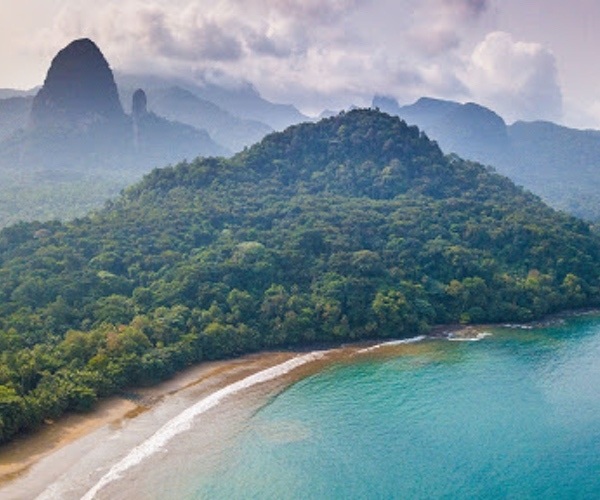 Two verdant tropical dots rise majestically from the deep blue ocean. São Tomé the larger of the two is the point of entry to the country, and São Tomé City is the hub of life on the islands. Please note that the terms “City” and “hub” are used loosely by Western senses. Life here happens more at the speed of the tortoise than the hare, and after a few days you will see that it is so much more rewarding that way. A riot of colour assaults the senses from the bright yellows of the taxis to the faded pastels of once grand Portuguese colonial structures. Brightly coloured houses give way to pavements strewn with a rainbow of fruit and vegetables as hawkers sell their bounty.
Two verdant tropical dots rise majestically from the deep blue ocean. São Tomé the larger of the two is the point of entry to the country, and São Tomé City is the hub of life on the islands. Please note that the terms “City” and “hub” are used loosely by Western senses. Life here happens more at the speed of the tortoise than the hare, and after a few days you will see that it is so much more rewarding that way. A riot of colour assaults the senses from the bright yellows of the taxis to the faded pastels of once grand Portuguese colonial structures. Brightly coloured houses give way to pavements strewn with a rainbow of fruit and vegetables as hawkers sell their bounty.
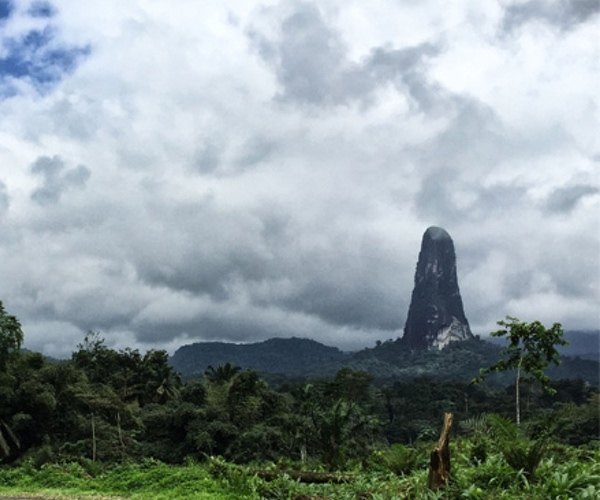 Inland the forest is king, dense and rich and teaming with life, shrouding the mountainous terrain. The Pico Cão, unwilling to be subjugated to the jungle surrounds rises straight up nearly 400m above the forest, dominating the views from far and wide. On the fertile lower slopes plantations produce abundant crops from the fertile soil, including the island’s celebrated cocoa trees. In the early 1900’s this tiny nation was the world’s largest producer of cocoa earning them the nickname the “Chocolate Islands”. Even today São Tomé cocoa is considered some of the finest in the world.
Inland the forest is king, dense and rich and teaming with life, shrouding the mountainous terrain. The Pico Cão, unwilling to be subjugated to the jungle surrounds rises straight up nearly 400m above the forest, dominating the views from far and wide. On the fertile lower slopes plantations produce abundant crops from the fertile soil, including the island’s celebrated cocoa trees. In the early 1900’s this tiny nation was the world’s largest producer of cocoa earning them the nickname the “Chocolate Islands”. Even today São Tomé cocoa is considered some of the finest in the world.
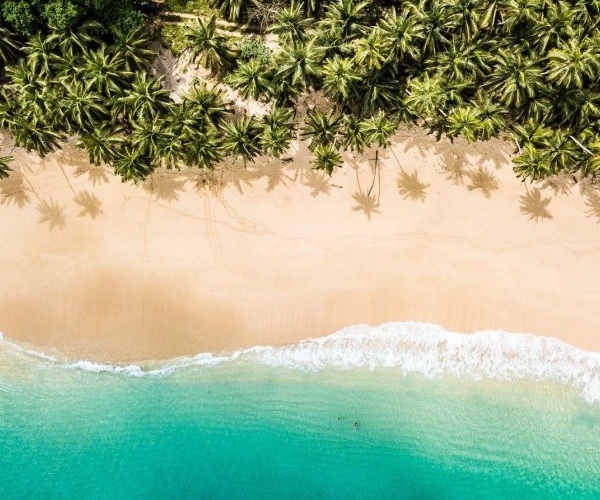 A short flight north east takes you to the smaller of the two islands, Príncipe. If São Tomé is laid back, Princípe is positively comatose. You may want to take an excursion deep into the forests, or maybe explore one of the cocoa plantations or even head off in search of nesting turtles, but you could just relax on one of the islands achingly beautiful beaches instead. After all, you have come here to get away from it all, and here you are just about as far away from modern life as you can get, so just revel in it.
Warwick Blow is Owner of Safari In Style. Safari In Style uses more than 50 years of personal experience to create tailor-made unique journeys through Africa’s finest safari destinations.
If you would like to be a guest blogger on A Luxury Travel Blog in order to raise your profile, please contact us.
A short flight north east takes you to the smaller of the two islands, Príncipe. If São Tomé is laid back, Princípe is positively comatose. You may want to take an excursion deep into the forests, or maybe explore one of the cocoa plantations or even head off in search of nesting turtles, but you could just relax on one of the islands achingly beautiful beaches instead. After all, you have come here to get away from it all, and here you are just about as far away from modern life as you can get, so just revel in it.
Warwick Blow is Owner of Safari In Style. Safari In Style uses more than 50 years of personal experience to create tailor-made unique journeys through Africa’s finest safari destinations.
If you would like to be a guest blogger on A Luxury Travel Blog in order to raise your profile, please contact us.Did you enjoy this article?
Receive similar content direct to your inbox.


Am I right in assuming that “a touch of robust geological activity” means that you can expect some earth tremors and volcanic activity? After our recent earthquake in Bedfordshire in the U.K. it seems that you can expect the earth to move beneath your feet almost anywhere on the planet.
Hi Roger
This is the point at which the African and Arabian tectonic plates meet and an area that has considerable volcanic faults. Having said that the last few years have been remarkably quiet when it comes to volcanic and seismic activity.
A lot of clients do actually combine Ethiopia and the Erta Ale Volcano with a Djibouti trip for a chance to visit an active volcano.
Long run though I’d rate my chances of less activity in Bedfordshire than in Djibouti!
Regards,
Warwick
You’ve got to relax on a beach at the end of a safari though some people say it’s best to chill out before your safari so you are all ready to go. But I’ve never heard of São Tomé and Príncipe – would be good to give them a try.
Morning Kate,
Oh I definitely agree there is nothing quite like relaxing on a beach after a safari (I am definitely in the camp that says after the safari). On http://www.safariinstyle.com we have a few suggested itineraries doing just that – and often our clients choose to end in Mozambique, Zanzibar, Seychelles or Mauritius.
São Tomé and Príncipe is definitely the place to get away from it all for total relaxation. The only slight negative is getting there from some of the main safari destinations – especially at the moment.
But that road less travelled sure has some great rewards.
Kind regards,
Warwick
I’ve always said that there’s far more to Africa than most people think. If you’ve read the piece above I think you’ll agree that Africa has got so much variety, so much going for it. On top of that all the pictures are very different as well.
Hi Gary
Never a truer word – few people even realise Africa is the second largest continent on earth. There is so much to be explored and the great thing is that there is something for everyone in Africa…all just waiting to be explored.
Warm regards,
Warwick
These are really great destinations to choose from, I’ve been dying to go to Egypt for quite some time now, but I don’t know their quarantine protocols and if they are open to visitors and tourists from other continents. I’ve visited the Serengeti a while back and I had the pleasure of witnessing the Great Wildebeest Migration, it made my jaw drop to the ground. It was amazing to see these animals you only see on TV together in groups and to see it in person left me in awe. I heard some countries in South Africa recently opened their borders to tourists such as Kenya. Finally, some semblance of travel and tourism. It’s great to see how they are trying to slowly recover from the pandemic. I hope I can visit South Africa soon, might also take a detour to Chad and Egypt.
Hi Kelise
Thanks so much for the comment. Wow you got to see the migration, that really is one of the great wildlife wonders of the world!
Yes, fortunately there are a few countries now slowly starting to open their borders for travel. South Africa opens on the 1st October and as of right now we are still waiting to hear which countries will be allowed to enter (hoping the list is published very soon), but places like Zambia, Kenya, Tanzania, Rwanda and Namibia are all ready, with more coming in the next few days. Very exciting times.
If you need any help when the time is right for you to travel we would be more than happy to assist.
In the meantime, happy daydreaming!
Kind regards,
Warwick
I really enjoyed reading this piece, there’s some very enjoyable out of the box thinking going on here. It’s quite a reminder as to what a huge continent Africa really is and how much variety that continent has. It’s been quite inspiring to get some original ideas from this on my next trip to Africa.